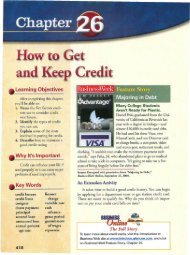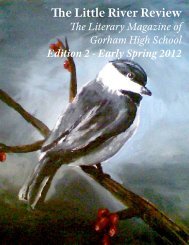Program of Studies 2011-2012 - Gorham High School!
Program of Studies 2011-2012 - Gorham High School!
Program of Studies 2011-2012 - Gorham High School!
You also want an ePaper? Increase the reach of your titles
YUMPU automatically turns print PDFs into web optimized ePapers that Google loves.
asics <strong>of</strong> design, drawing using CAD, creating various types <strong>of</strong> drawings common to different industries and 3D<br />
modeling <strong>of</strong> design ideas.<br />
966D Introduction to Architectural Drawing WRVC<br />
0.5 Credit<br />
If you have any interest in becoming an architect, this course is for you. This introductory course will focus<br />
learning the basic <strong>of</strong> drawing with an architectural Computer Aided Design (CAD) program. The activities will<br />
include learning to draw using CAD, creating various types <strong>of</strong> architectural drawings common to different trades,<br />
applying dimensions to a drawing and printing drawings at different scales.<br />
967A CAD 2 Mechanical or Architectural WRVC<br />
1 Credit<br />
Students will choose between mechanical or architectural design. In the mechanical design advanced class,<br />
students will develop products <strong>of</strong> their own design and produce a set <strong>of</strong> drawings that could be used for<br />
manufacturing <strong>of</strong> the item. Students will learn about manufacturing process, industrial standards and design<br />
practice that apply to their product. Advance CAD skills will be covered.<br />
In the architectural design advanced class, students will design residential and commercial buildings. They will<br />
start out by first designing a two-story house. Next, they will create a design for an <strong>of</strong>fice building. Students will<br />
learn advance CAD skills that will help them better develop their idea in 2D and 3D models. Students that take<br />
the architectural program will also work on designing the house the Building Trades program constructs every two<br />
years.<br />
Prerequisite: Mechanical Design 1 or Architectural Design 1 or Intro to Engineering or Intro to<br />
Architectural.<br />
967B 3D Modeling Mechanical or Architectural<br />
1 Credit<br />
Students will choose between mechanical or architectural program. They will either use Inventor (a 3D<br />
mechanical modeling program) or Revit (an architectural 3D modeling program). With either <strong>of</strong> the programs,<br />
students will use them to build 3D model or projects. They will learn to manipulate the object, build assembles <strong>of</strong><br />
pieces, make changes to their parts and turn their 3D models into 2D drawing.<br />
Prerequisite: Mechanical Design 1 or Architectural Design 1 or Intro to Engineering or Intro to<br />
Architectural<br />
EARLY CHILDHOOD OCCUPATIONS:<br />
The Early Childhood Occupations Education <strong>Program</strong> is a program designed for students preparing for careers<br />
involving children. Students should love children, have good communication skills, be responsible, be<br />
dependable, work well independently, and read to grade level. Tech I students will participate in nursery school<br />
four days per week every other week working with 3 ½ to 5 year olds. While working in the nursery school,<br />
students will work within teams, planning and implementing activities according to a curriculum theme. Tech II<br />
students will participate in nursery school three days per week in one semester working with 3 to 3 ½ year olds.<br />
They will also intern for one semester at a community based program or class appropriate to career goal.<br />
956 Early Childhood Occ I WRVC 2 Credits<br />
957 Early Childhood Occ II WRVC 3 Credits<br />
ELECTRICITY:<br />
This program is designed to provide entry-level skills into the electrical field. Students learn to install wiring<br />
systems from blueprints and according to the National Electrical Code. Participants will learn to wire residential<br />
and commercial projects. Students work on safety at all times in the course. Students will wire splices, low<br />
voltage systems, non-metallic and metallic cables and wiring in conduits. Ohms Law calculations are used<br />
frequently. A vast amount <strong>of</strong> time is spent practicing switching circuits. Students are exposed to real world<br />
situations every day. Moral business practices and finances are discussed frequently.<br />
968 Electricity I WRVC 2 Credits<br />
969 Electricity II WRVC 3 Credits<br />
HEAVY EQUIPMENT OPERATION:<br />
This program will include basic construction safety, introduction to site work and roadwork layout, identification <strong>of</strong><br />
heavy equipment and use, and proper operation and preventative maintenance. Operation skill development will<br />
be performed on excavation simulators. Additionally, students will learn basic skid steer, excavator, dozer, front<br />
end loader operation and can receive the 10-hour OSHA safety certificate. The student text book will be from the<br />
National Center for Construction Education and Research. Class and lab work will be supplemented with field<br />
<strong>Program</strong> <strong>of</strong> <strong>Studies</strong>: <strong>2011</strong>-<strong>2012</strong> Page 29





